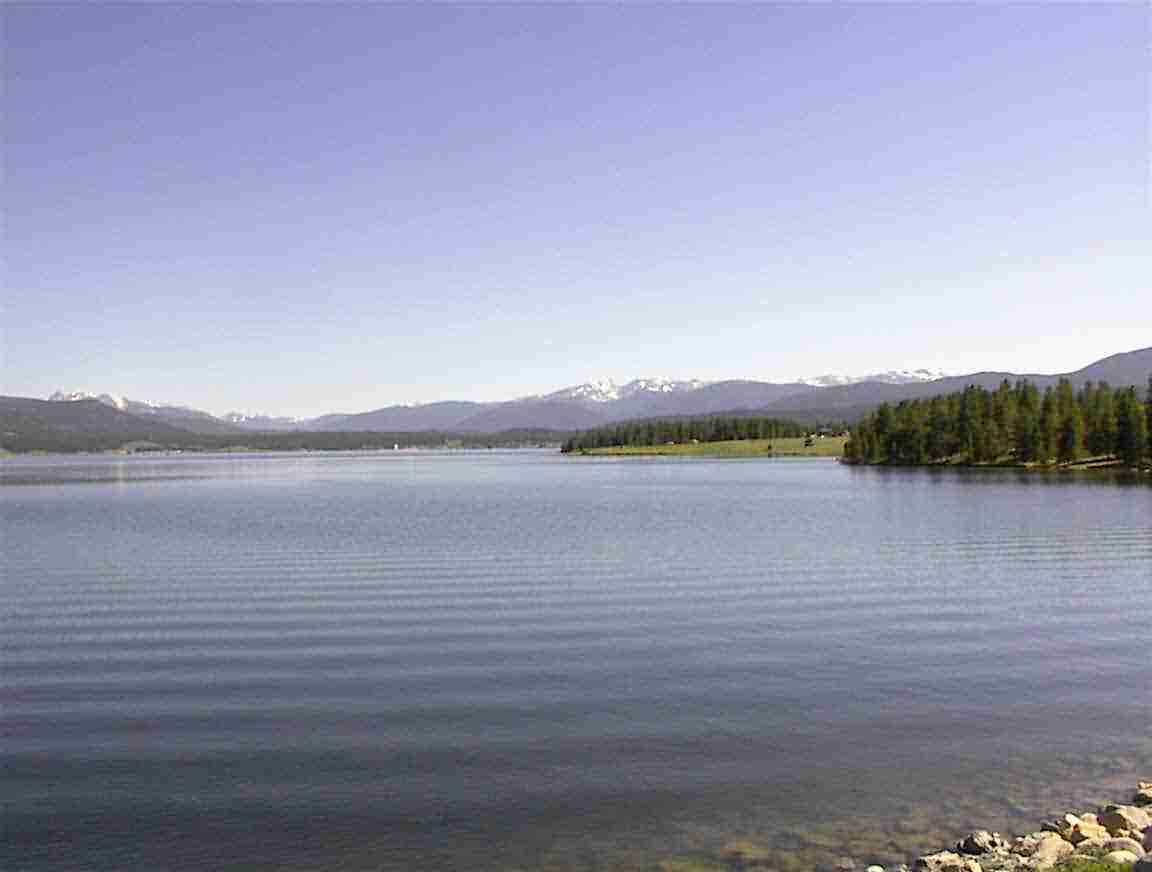
21 June - Day 23: Lake Granby CO to Estes Park CO - 107.2 km @ 16.6 km/h
Boy was I tired this morning. I just couldn’t get up even though I had 9+ hours of sleep. Yesterday’s ride had obviously taken a lot more out of me than I thought. Even when I finally emerged blurry eyed from my tent I had trouble focusing my eyes. Not an auspicious day for an ascent to over 3800 m …
I had a leisurely breakfast and watched someone fly fishing on Lake Granby. It appears to be a popular spot since the campground was large and yet was half-full, even before the advent of summer. The woman host came by and gave me some pineapple chunks to see me on my way "you’ll be needing all the energy you can get today" she said – and she was right! After breaking camp I cycled back across the dam and looked across the tranquil waters. As you can see from the photo below, it really was idyllic, although I suspect at the height of summer when inundated with power boaters it may be less tranquil.

I cycled back to the road and headed up route 34. It was relatively developed with lots of cottages, shops, restaurants, etc. This is obviously a popular tourist place. I had a chuckle at one place who deserves an award for truth in advertising. Let me explain. I’ve stayed at ‘Budget’ motels who have charged 50% more than was reasonable; ‘Quiet’ campgrounds where the noise of traffic keeps one awake; and come across a myriad of other situations where the truth was stretched to its limits. Well, this place advertised warm beer and lousy food. Finally someone who is either honest or else is aiming a clientele who want to prove them wrong …

Shortly after this I met up with another cyclist, Brent, who was out for a ride. He joined up with me and I had the pleasure of his company for most of the rest of day. He was a Canadian who was working at a Christian youth camp near Fraser, south of here. He came to Colorado as a teenager when his father, who was in the Canadian Air Force, was sent to Colorado Springs from Northern Alberta. Now for those of you who don’t know that part of Canada the best way of describing it is six months of winter and six months of bad skiing. We are talking a very bleak and harsh environment. His dad apparently decided that having +10 degrees in the middle of winter at Colorado Springs was infinitely preferable to –40 degrees in Alberta so he stayed on and retired here. I can relate. Canada would be the best country in the world were it not for its terrible winters. That is one of the reasons that I originally went to N.Z. Brent and I related stories of standing at the bus stop in winter banging our feet to try and keep warm and agreed that the more temperate climates are much more to our liking.
We cycled up to Grand Lake and from there towards Rocky Mountain National Park. This is a large park in northern Colorado which is home to many mountains and is quite stunning. My mission today was to cross this range and from there enter the great plains.
The road wound upwards towards the mountains in the distance. For about the first 20 km of travelling that day it was flat to rolling. I was definitely lacking my usual ooomph but it was great having Brent along and I did my best to keep up a respectable pace, although it was a lot slower than he would have gone on his own. The road gradually winded its way up towards the mountains as you can see from the two photos below.
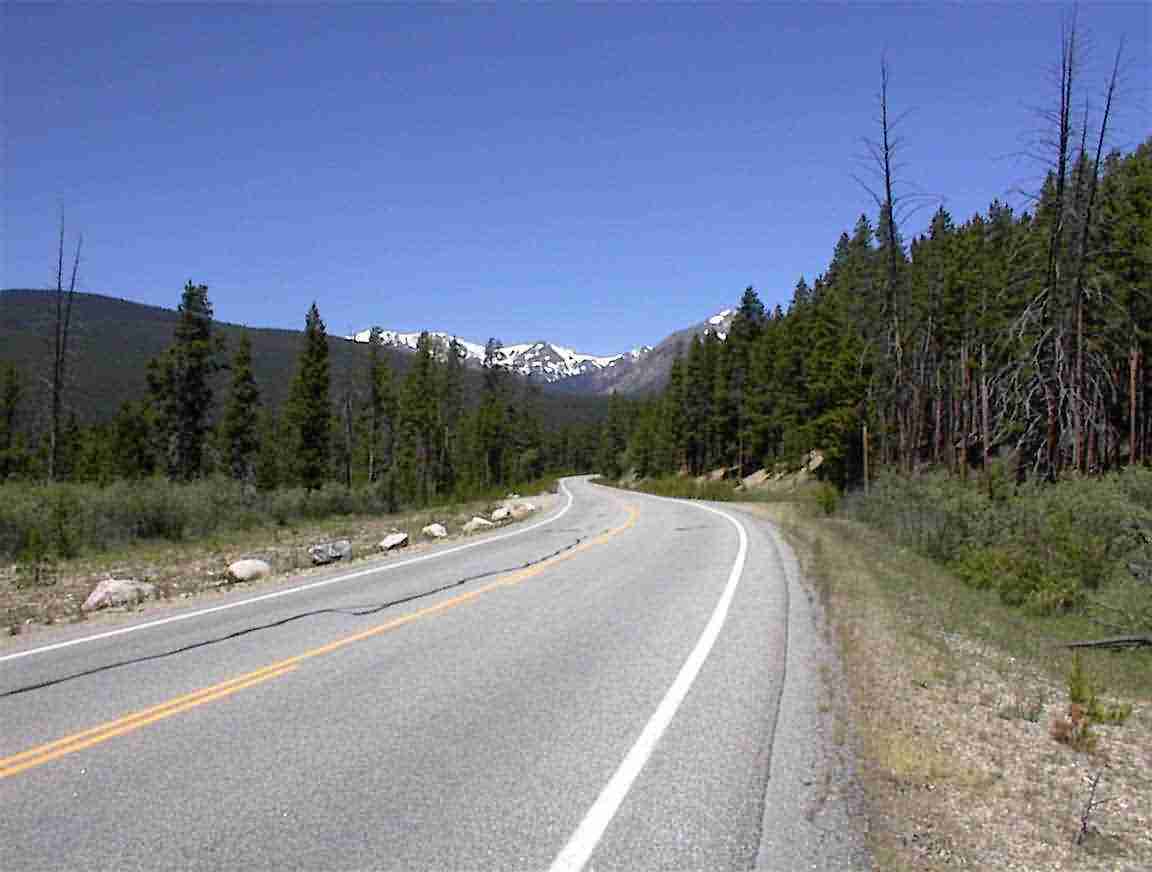
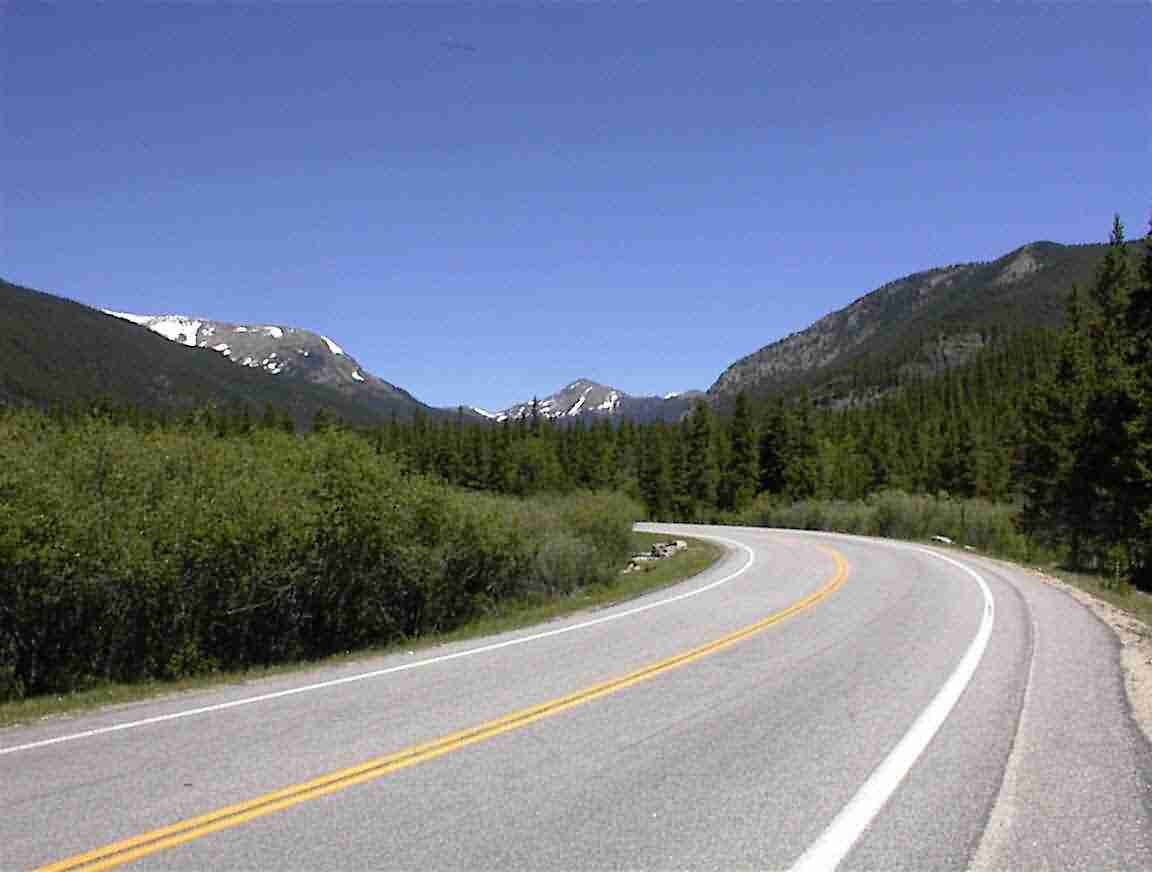
We met JJ who was coming downhill. Unlike many of the ‘serious’ cyclists, she stopped to have a chat and also to she some of the layers of clothes she was wearing. Originally from Texas, she was still patriotic and was wearing a Texas cycling shirt. She was now living in Denver and had come up to the park with some visiting friends who dropped her off to cycle down. She had a very fancy titanium bicycle which came apart into two and could be easily shipped on a plane. I was impressed but it probably cost a bucket. I have found it fascinating just how many things there are to spend your money on when it comes to a sport in America, and cycling seems to particularly suffer from this where you can choose from an array of high and higher tech components. Brent was riding a bike with 25 year old components and wasn’t wearing any of the fancy gear, yet he was still able to enjoy the sport. He didn’t even wear the skin tight lycra shorts that are so popular amongst cyclists – due to his having an extra hard posterior according to his wife.
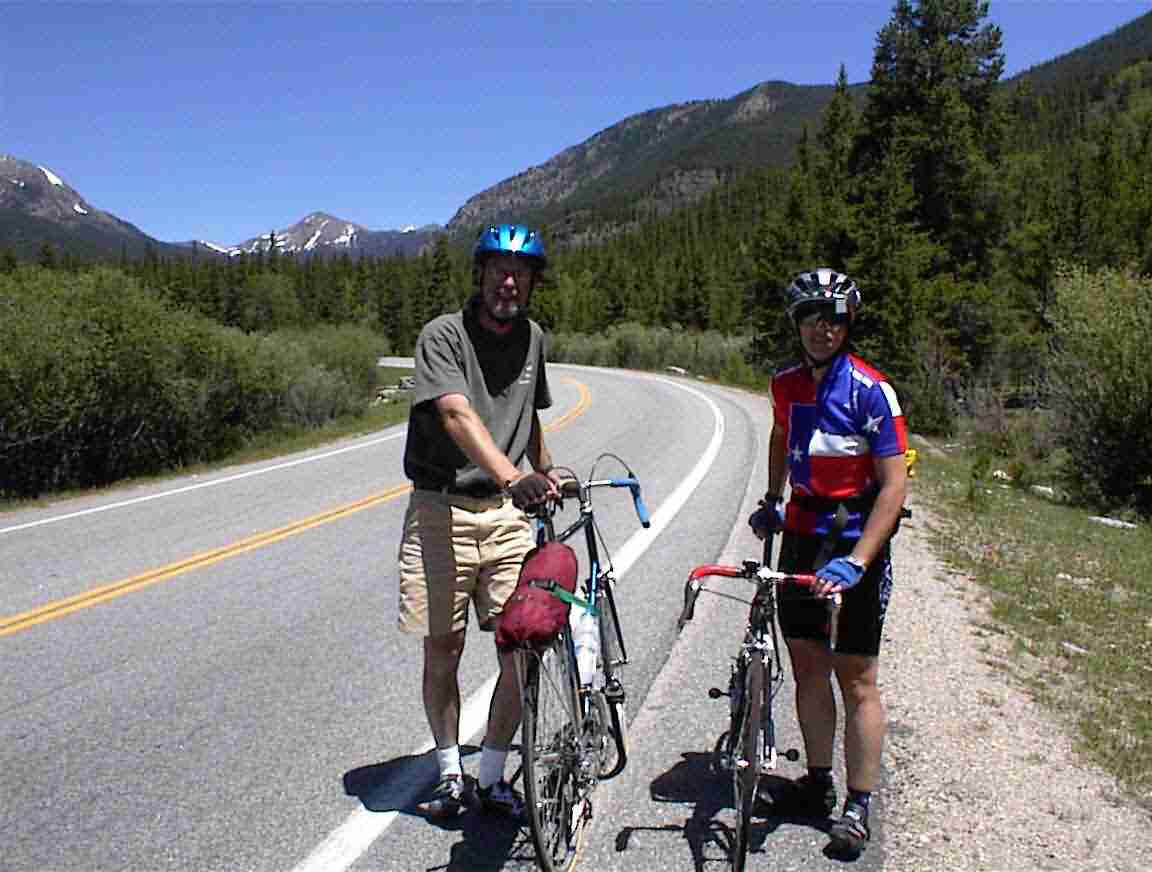
As we cycled we discussed a radio interview that we had heard that morning. Apparently, a member of Congress wants to issue an official apology for slavery. I don’t mean the modern slavery that takes place in places like the Sudan or south Asia, but for the slavery that was done away with after the American Civil War. During the interview it was mentioned that this has been termed ‘America’s Original Sin’ and it is necessary to make an apology to African Americans for this. Without the apology there will never be reconciliation and racial harmony.
Now I know that I have sometimes been accused of being to the right of Genghis Khan when it comes to political matters, but I found this to be absolutely incomprehensible. If these politicians want to see America’s original sin I suggest that they cycle through the wastelands that are the reservations of the Ute Indians like I did just a few days ago. Brent agreed and said that as part of his hisory degree he had to read newspapers from the 1880's and it was shocking to see that Indians were viewed as "vermin" who needed to be irradicated. Explains a lot.
I was also appalled at the lack of understanding of American history amongst the politicians – not that I am an expert but I have read extensively. Many seemed to be unaware that Abraham Lincoln, instead of being the great supporter of freedom for the slaves, voted in favour of slavery legislation before he became president and that the proclamation of emancipation came not at the start of the war, but well into it. They also seemed to be unaware of aspects of the Civil Rights Movement (in the interview the politician couldn’t even get the name right), and both its achievements and failures. Anyway, with politicians like these espousing their solution to racism in America in the form of an apology for something that happened over 130 years before, one can forget about anything meaningful happening. End of diatribe – except for one final fact. Most Americans don’t appreciate that one of the primary forces which reduced slavery was the Royal Navy. Their concerted actions during the first half of the 19th century after its abolition in the U.K. shut down many of the west African slave ports – much to the chagrin of the American slave traders.
Eventually we reached the hilly part and started up the road. It was a series of switchbacks which took us up and up. There were pine trees all along the slopes and their sweet scent pervaded the air. This was offset to a certain degree by the smell of burning brake pads from vehicles descending down the hill. The drivers were most patient and seemed to accept that these two slow cyclists deserved to have a bit of space. They often waited for several minutes while we negotiated a curve before passing us. That was most appreciated. There were no trucks, since they are not allowed through the park, and very few RVs. Brent said that they discourage them because of the winding road. Great for us cyclists!
We stopped for refreshments several times by the side of the road. It was hard work and the sustenance was needed. The following is a photo of me sitting on one of the roadside walls. As you can see, there is not a lot of space and this was typical of the road all the way to the top. The second photo gives you an idea of the change in terrain, how we had come from a valley and now were on our way up the mountain.
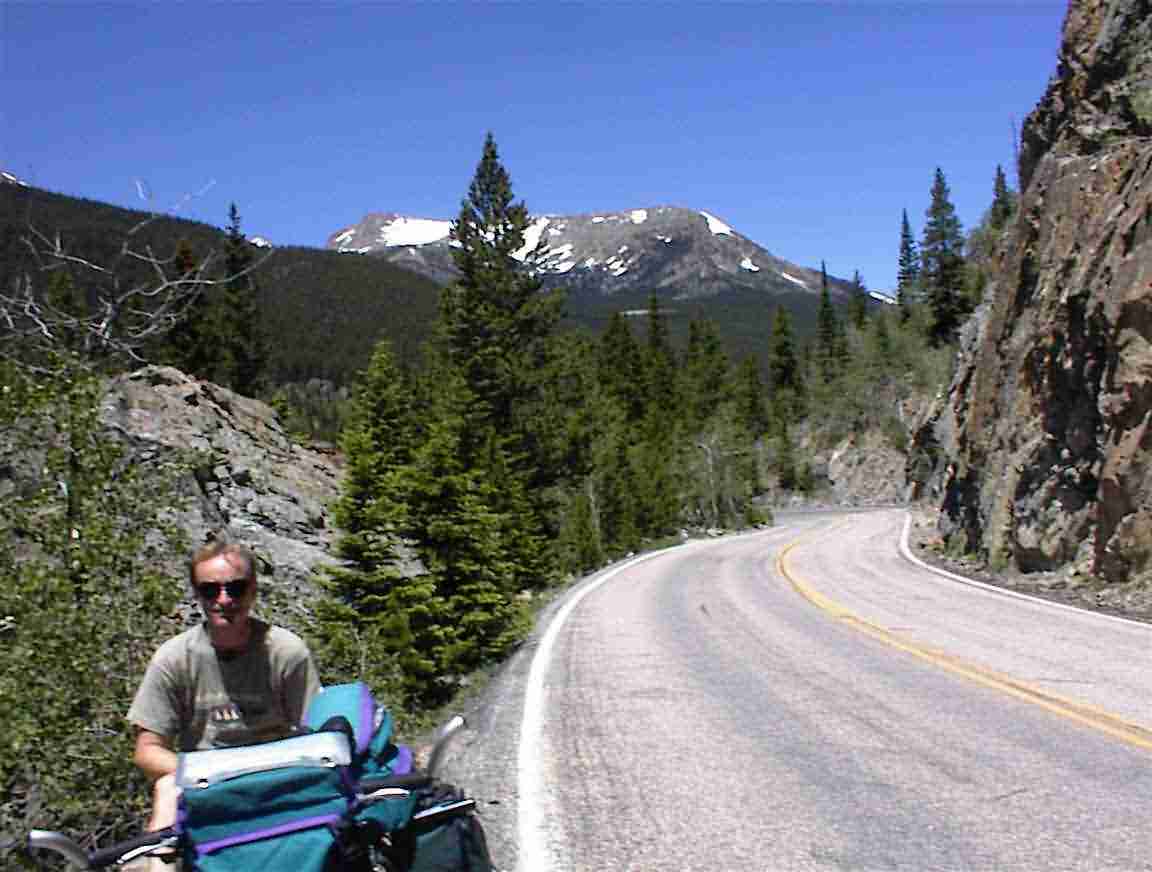
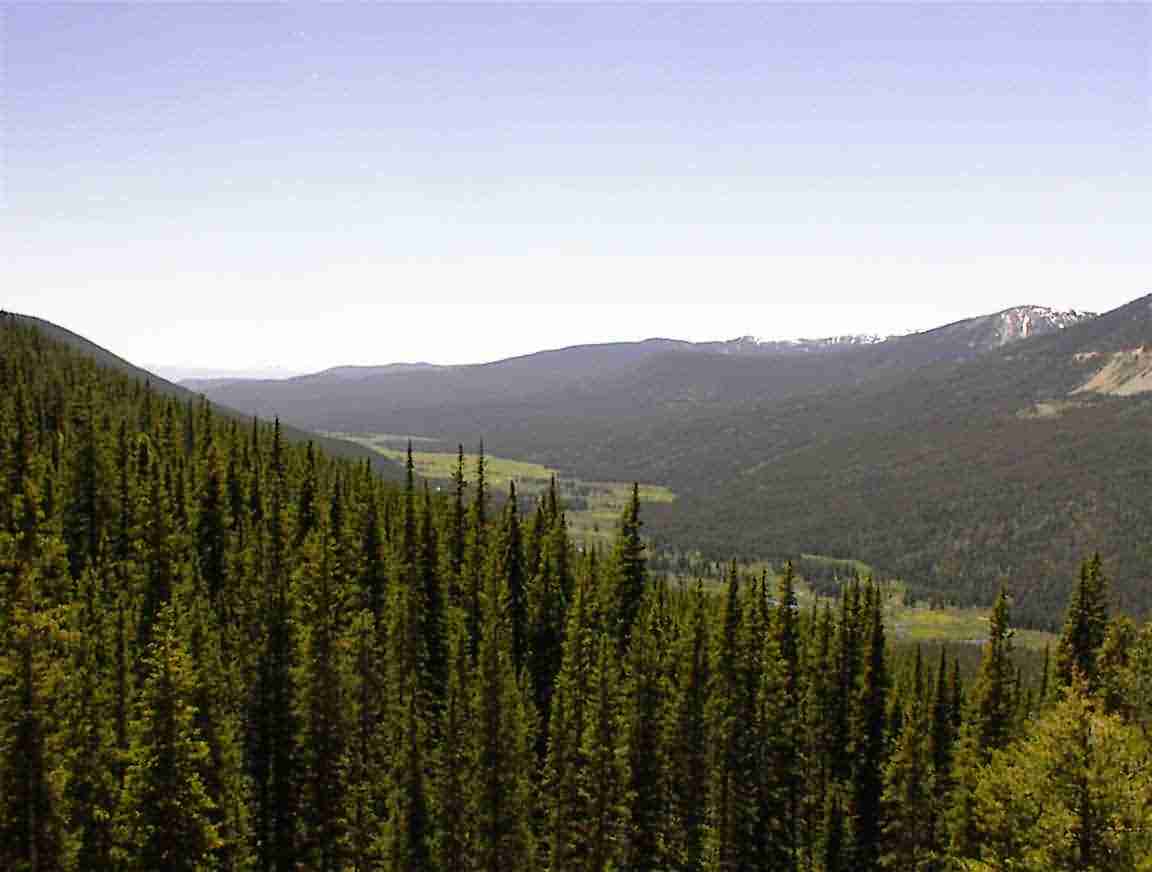
The road went up and up. Brent and I discussed his work. It was an inter-denominational camp which was supported by donors. The organisation has been in existence for almost 60 years and relies on a combination of donations and fees from the campers. He said that he was amazed at how generous some people were; one person recently donated $1.25 million towards the construction of their new camp. And that is $US not $NZ. There are a lot of wealthy benefactors here, but that may be due to this insidious tax called an estate tax where the US Government can get a sizeable chunk of your estate when you die. Both George Bush and Al Gore have promised to repeal the tax if elected president so we will see what happens …
The objective of the camp is to reach unchurched teenagers and give them an exciting experience in nature. To that end they do all sorts of outdoor adventure activities as well as having a spiritual dimension to the camp. At the end of the camp they are channeled back into their local churches, be they Presbyterian, Lutheran, Baptist, or whatever, since they need to be supported by the local church once they went home. Sounded like a great programme.
I commented on the water issue and he explained to me the fascinating issue of water rights. When you buy a property in the Western USA there are two elements to the purchase; the land rights and the water rights. The latter allow you to draw so many acre-feet of water from the property. The problem that arises is that there are more acre-feet of water rights owned than there are acre-feet of water available so this leads to one of the favourite local pastimes: litigation. There are attorneys who only deal with water rights. It also creates an interesting situation in that one can sell the water rights while keeping the property. Thus, a city like Los Angeles may own the water rights to local properties. Quite fascinating, but understandable when you think how little water there is. The problem is particularly acute on the east side of the Rockies since that is where the cities like Denver are with all the demand for water.
We continued up and eventually came to the point where we could see beyond the treeline. The photo below shows the top of the mountains and that is basically the elevation that we had to cycle over.
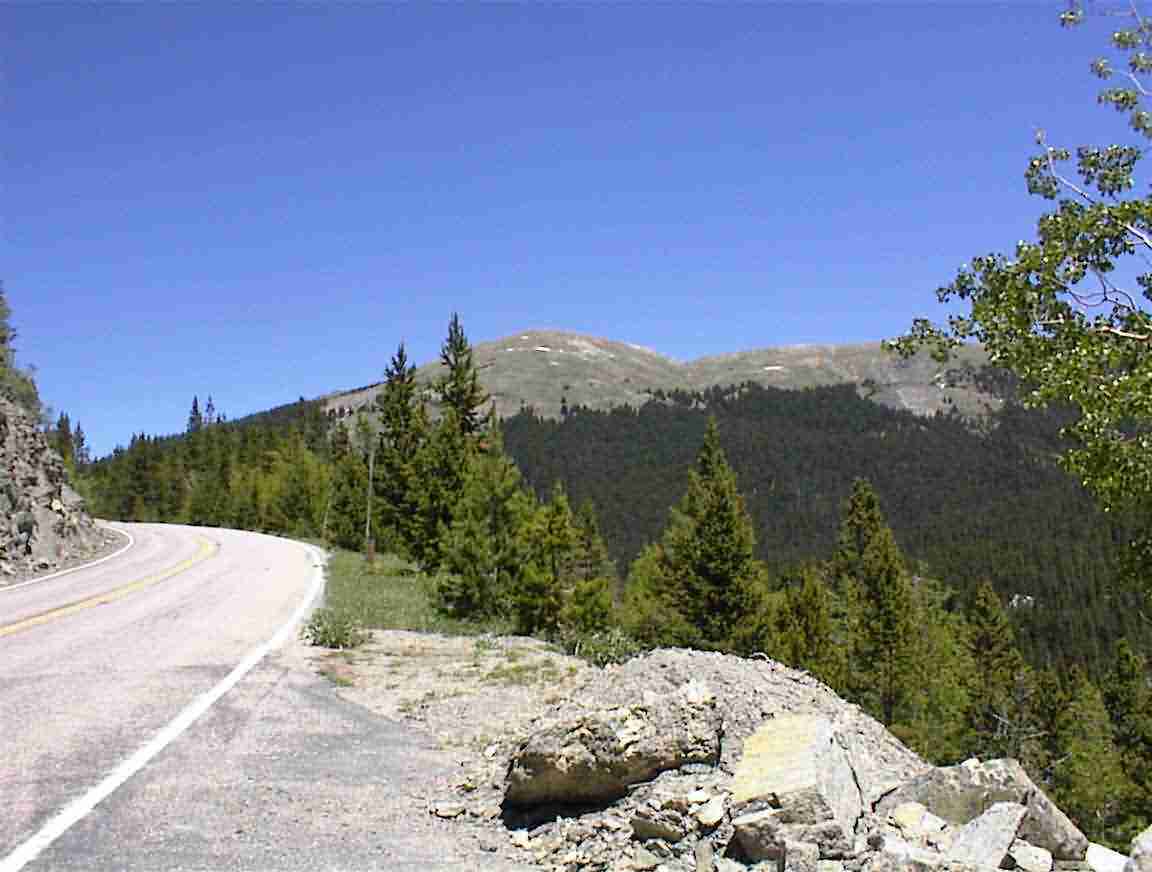
At Millner Pass I came to the (last) crossing of the Continental Divide at 3254 m. The photo below shows me and my bicycle in front of the sign. I was really pleased to make this mark, although I still had to ascend to 3685 m to reach the high point of my trip. I donne my special shirt for the photo below. A very special achievement!
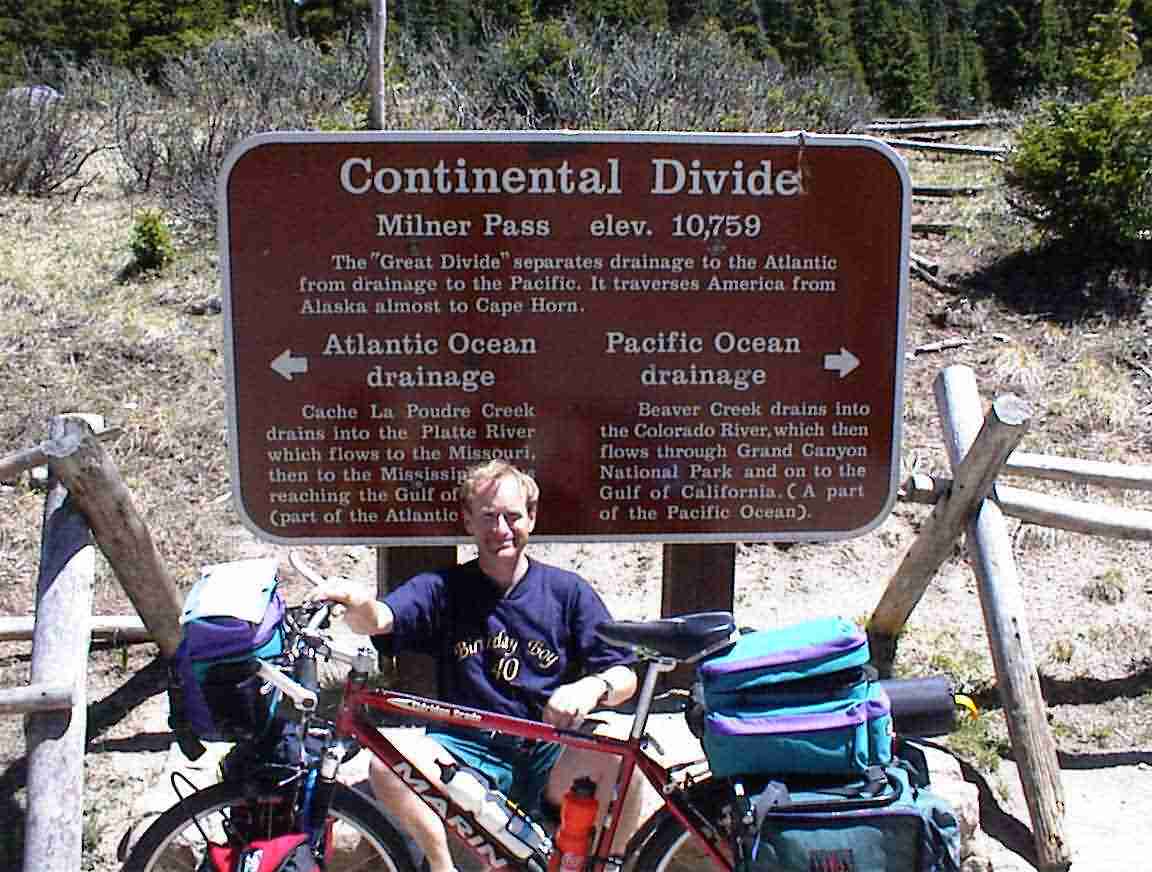
Lis and I were in this area last year and I recalled with pleasure our hikes along the trails. It made me miss her all the more since it brought back such fond memories. There was a volunteer ranger there offering advice to people and taking photos. She was about 70 and a keen cyclist – she was off to Ireland for a week long bike trip in two months! That is one of the beauties of cycling; you are never too old. She commented that Monday, when I got hit by the storm, they were inundated with snow on the road and it was closed since the snow plows couldn’t keep it clear. The wind was also gusting to 80 mph. Glad I was going over today since the day was beautiful and clear.
We continued up and up and up. The road was steep, but doable. I was in my low gear and peddled along at about 7 km/h. These photos give you and idea of what it was like.
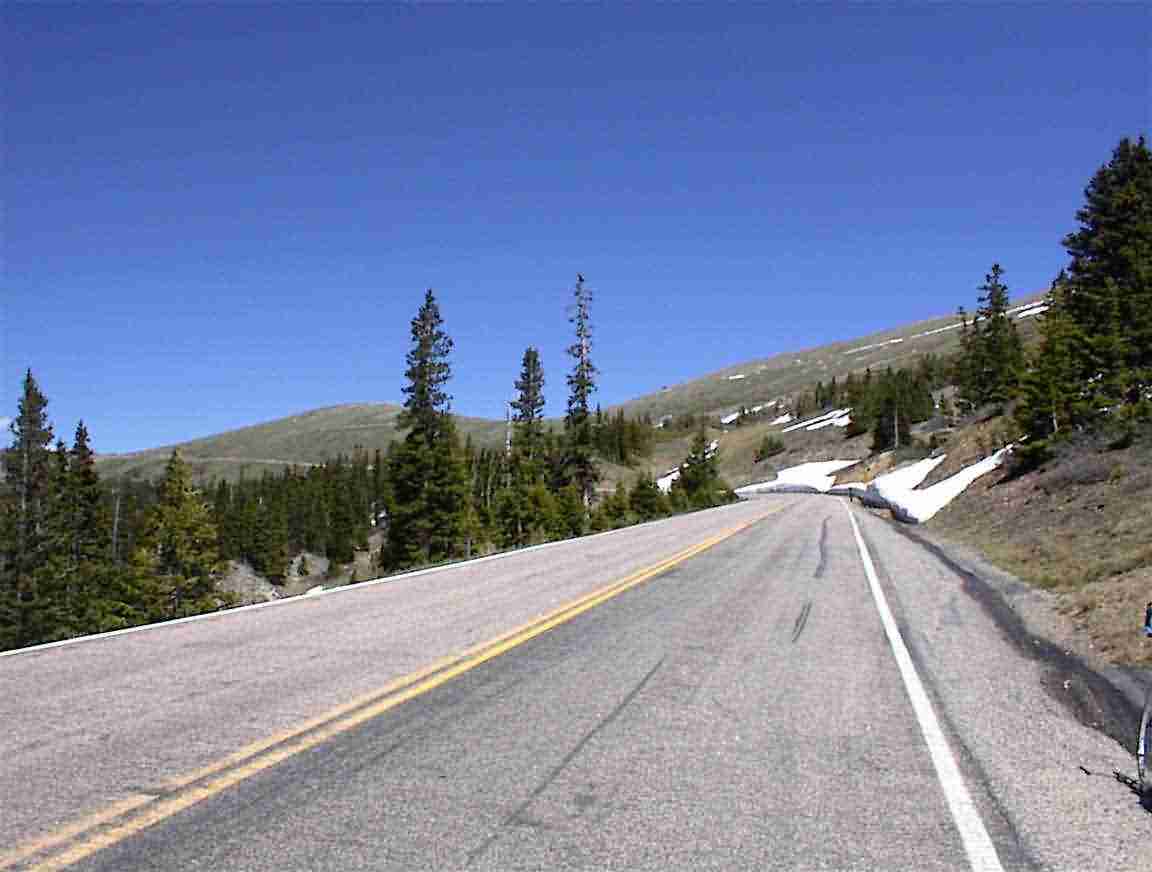
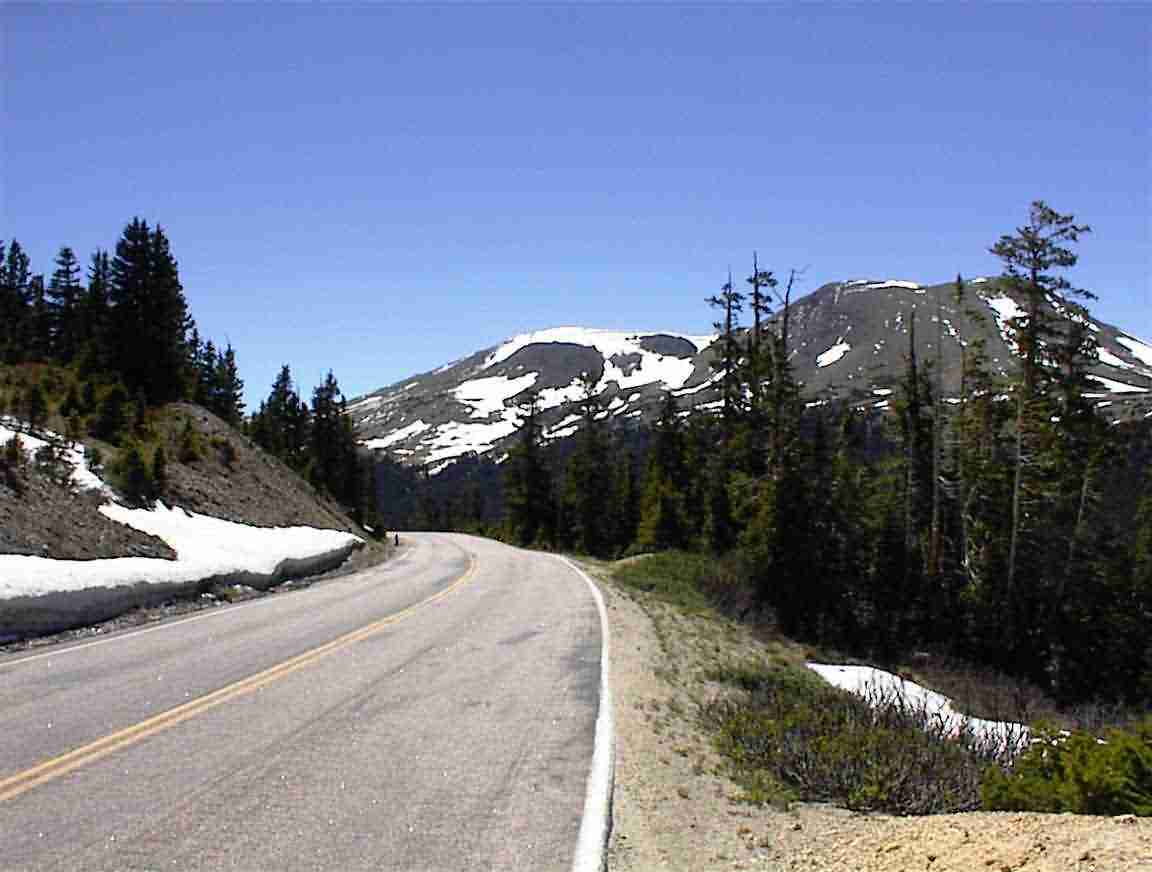
Not only were we above the treeline, but there was snow all about. I flopped into the snow and found it cold but refreshing. The altitude was really getting to me and I found it quite hard going. If you have not been above about 2000 m (7000') it is hard to describe but you just can't get enough oxygen to fill your lungs and completely catch your breath. You therefore breathe more often which takes more effort. Everyone is different and I've never been very good at altitude. It's even worse when I am sleeping since I am a very shallow breather. I often wake up gasping for air. In Nepal I actually stopped breathing which was frightening. I'd wake up gasping for air as if someone had put a bag over my head. But that's another story.
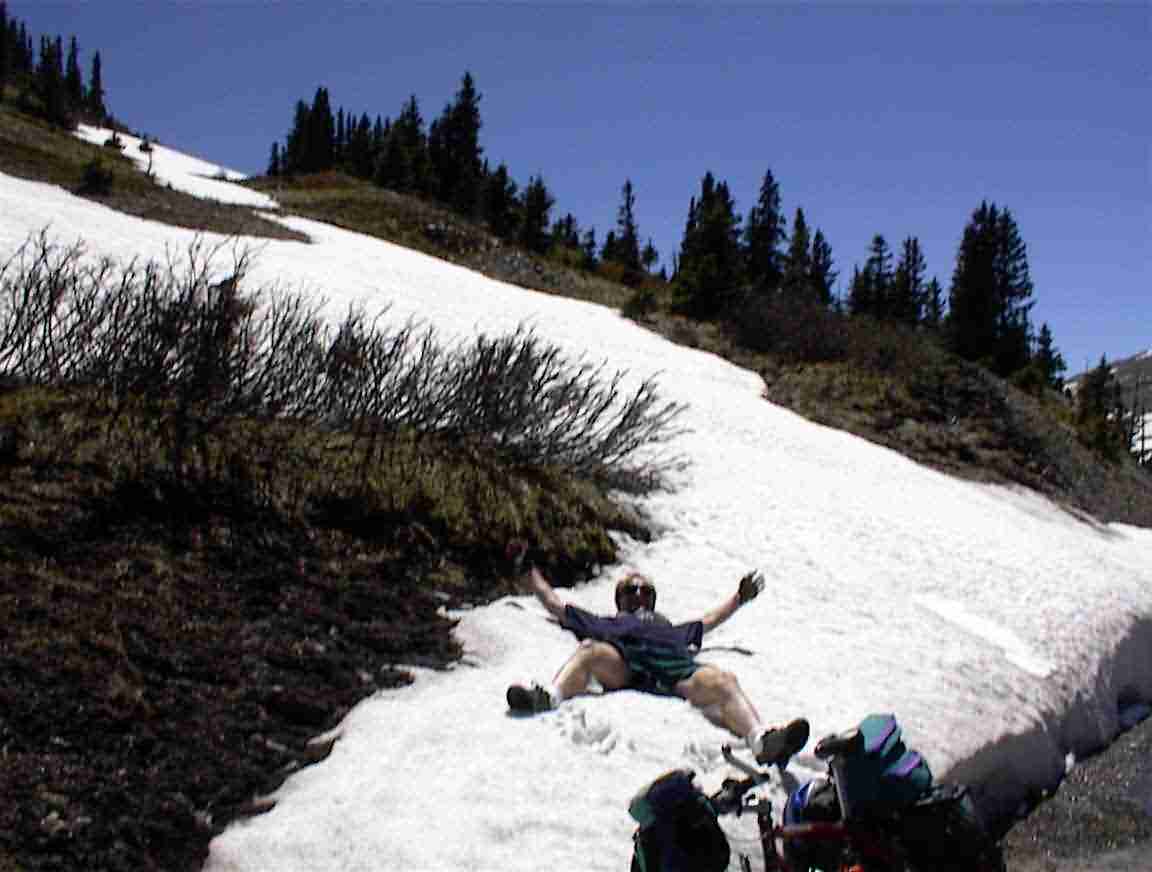
Brent scooted on ahead to a rest stop where there were great views up and down the valley. I eventually managed to join him.
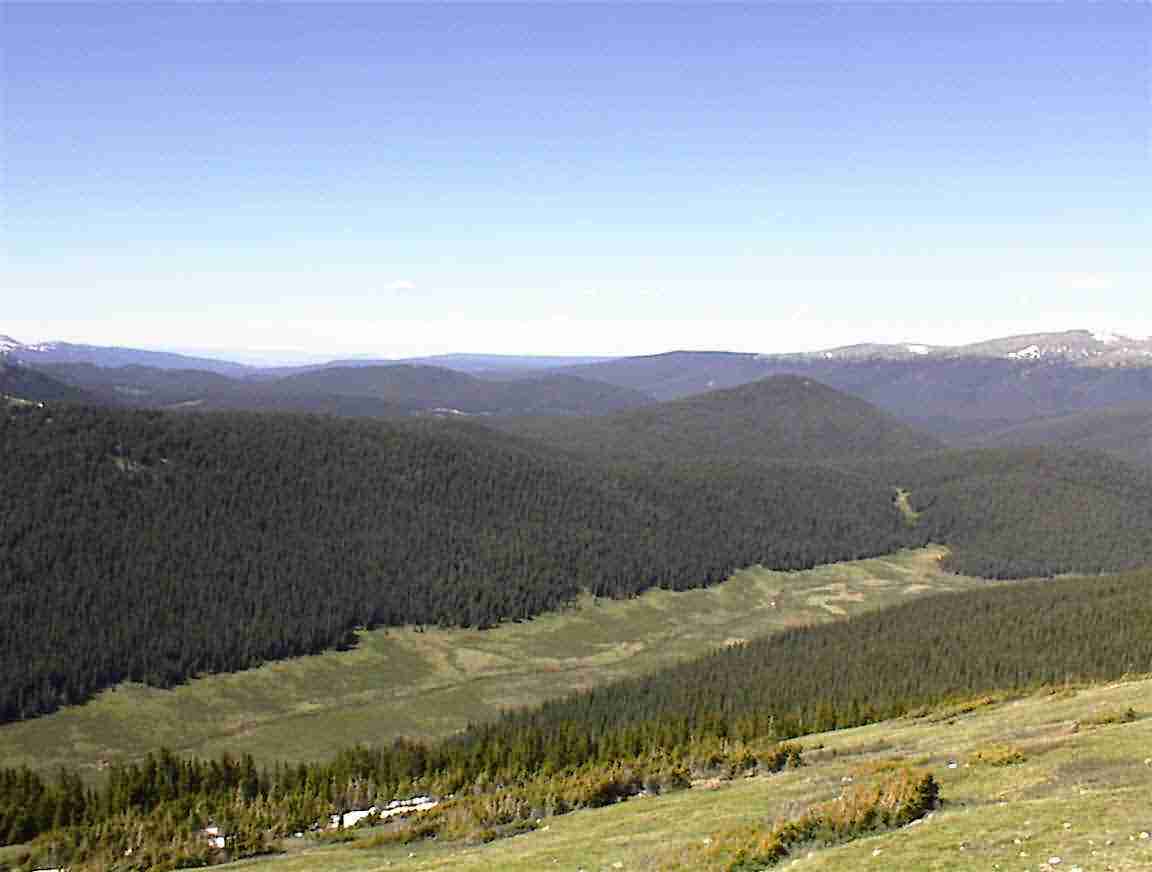
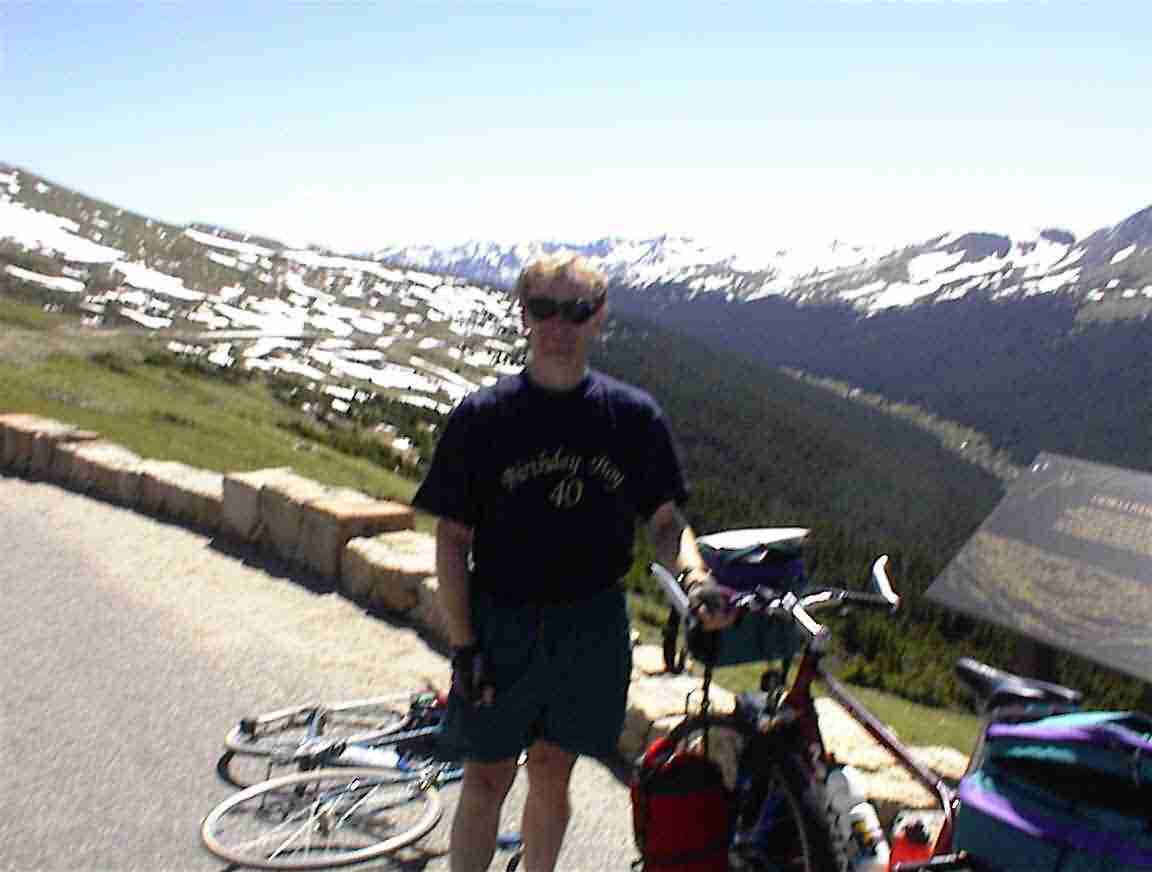
There were quite a few people at the lookout and our bicycles attracted them to find out why on earth we would do something like this. At least I have a goal – crossing the USA – while Brent was just out for a ride. There are two common observations (a) there is no way that I could do it and (b) how on earth do you get 10 weeks holiday. With regard to (a), it is surprising what one can do when one tries. I would say that this trip is about 70% psychological and 30% physical. The psychological tells you to keep on going when you are hungry and tired; the physical consists of the stamina. Brent told the story of a fellow he met when he cycled to Yellowstone Park. He was in his 70’s when he started cycle touring! With regard to (b), that is one of the few advantages of working for oneself. You just have to have the commitment to block out the time (and to have a very indulgent wife).
We cycled up to the Visitor’s Centre and I pointed out the trail which Lis and I were on last year when someone was hit by lightening. The volunteer ranger I met earlier recalled that incident and commented that there were two fatalities last year due to lightening. It’s really scary and although I’ve been advised that on a bicycle I don’t have much to worry about I will still take it careful. To give you and idea of how high we have ascended, the following photo looks back down the valley – and not to the bottom. We had climbed for about 40 km and it had taken about 7 hours, with stops.
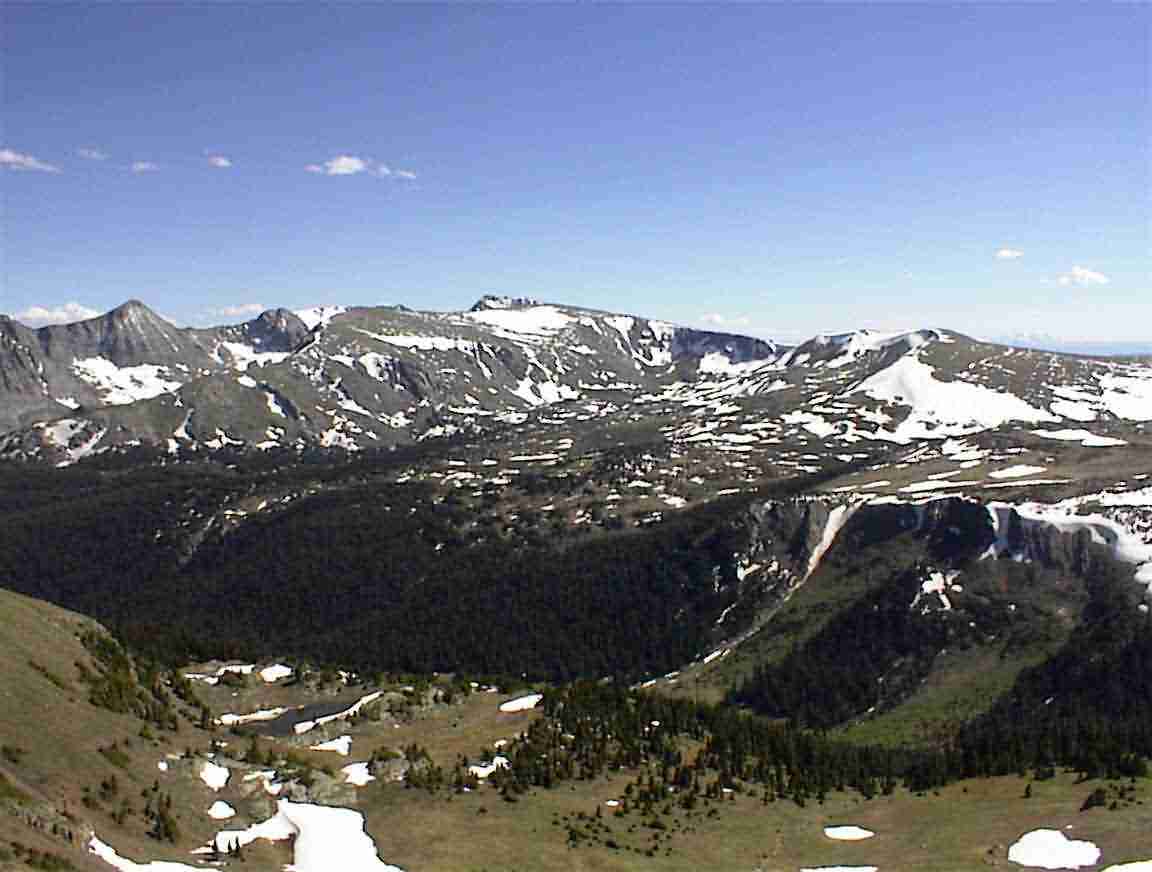
The road to the top was very narrow and there wasn’t much of a shoulder. Fortunately, there was no wind and the traffic gave us a wide berth, so it was OK. I had a chuckle the next day when I overheard someone complaining about being scared when driving that road. I said that she should try it on a bicycle!
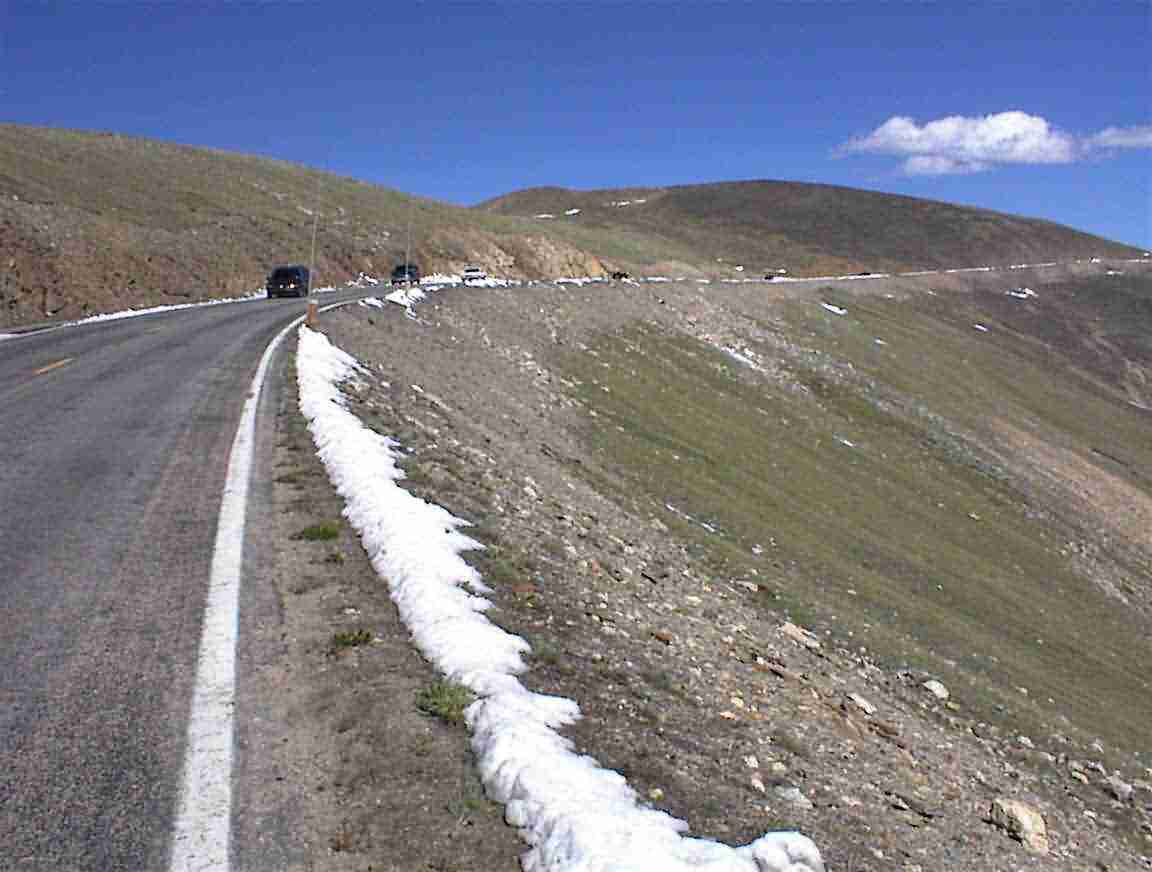
The views were stunning, as the following photos show. I also left a message in the snow. Similar to the one in the salt on the Great Salt Lake.
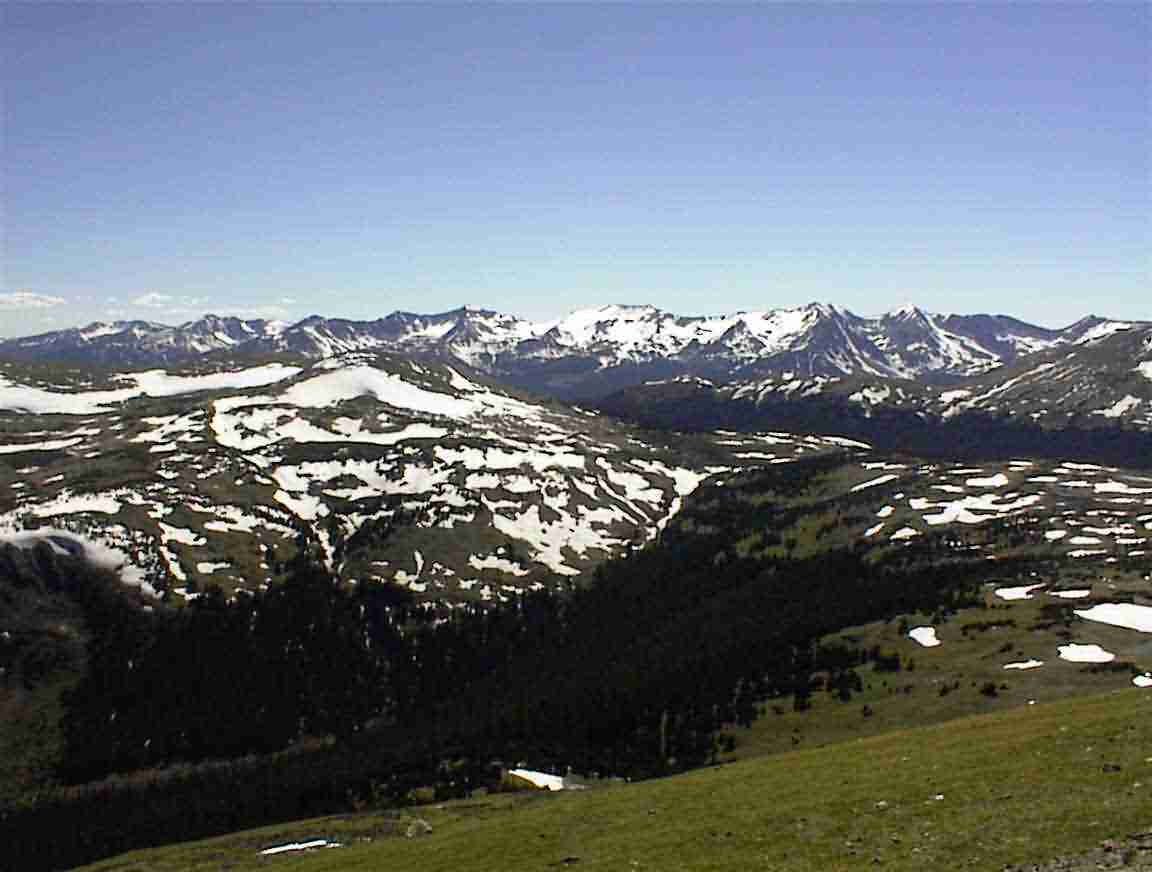


I could finally see the top of the road, it was to the left where you see the rocks in the following photo. I made it and had a friendly fellow (Dave from Austin Texas) take my celebratory photo. This is the highest point on my trip at 3685 m. I would also say that this was by far the hardest day since the combination of the mountains to climb and the reduced oxygen in the air made it very hard going. But I did it.
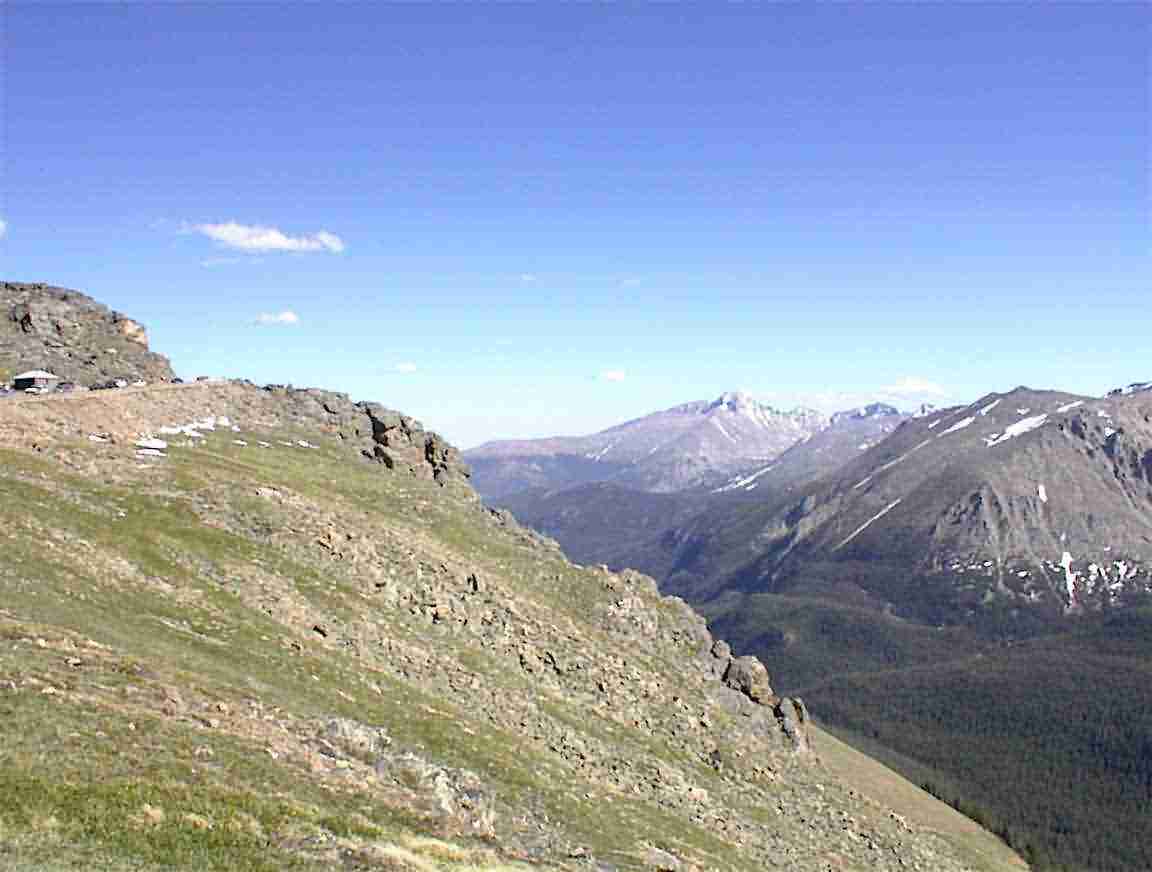

I started my downward ride and stopped regularly to admire the view. I met four women at one spot who came over and chatted. When I told them what I was doing they were amazed. One was from Lincoln Nebraska and was pleased when I mentioned that I was passing through there next week. She said it was a pity it wasn’t October as she would have taken me to a ‘Huskers’ game. When I enquired what a husker was she looked at me incredulously and said ‘Only the best college football team in America’. They were typical of most Americans I have met; friendly and very open.
It was a wheeeee ride down, but I kept my speed to 55 km/h which was the speed limit. I joined a long queue of vehicles which were travelling at that speed so put myself in the middle of the road and enjoyed the ride. It was about 18:00 and was getting cool so I was glad I was wearing my warm gloves and jacket. It was fine in the sun, but the shade was quite biting at times. Eventually I made it to the bottom and exited the park. Trail Ridge Road. It was a memorable ride.
I cycled into Estes Park and recognised a number of shops we had visited last year. The Pizza Hut we had walked out of due to poor service was now closed, but everything else was still there. It is a delightful tourist town with lots of tourist shops to visit. Recommended if you are in the area.
The Visitors Information Centre was open and I got a site at the KOA campground. It was overpriced but then tourist season is here so everything is expensive. While I was checking in a fellow grizzled to Wendy about the effort he made while up the mountain. She said that he shouldn’t complain as I had cycled it. From Ohio he had really felt the lack of oxygen and I could empathise. Still, it wasn’t as bad as at Everest Base Camp.
I went into town following a cycle path next to the lake to get some dinner and celebrate. It was a lovely ride with the mountains in the distance. I couldn’t find anywhere to eat so had to settle for Pizza. I’m so tired of Pizza. I returned to KOA by the same route and there was a deer on the bike path! After dusk they wander about town and I had seem them crossing the highway and impatient motorists honking them. Such idiots. I worked on my journal, had a shower, and collapsed for a good long sleep.
loans loans loans loans loans loans loans loans loans loans loans loans loans loans loans loans loans loans loans loans loans loans loans loans loans loans loans loans loans loans loans loans loansloans loans loans loans loans loans loans insurance insurance mortgage mortgage